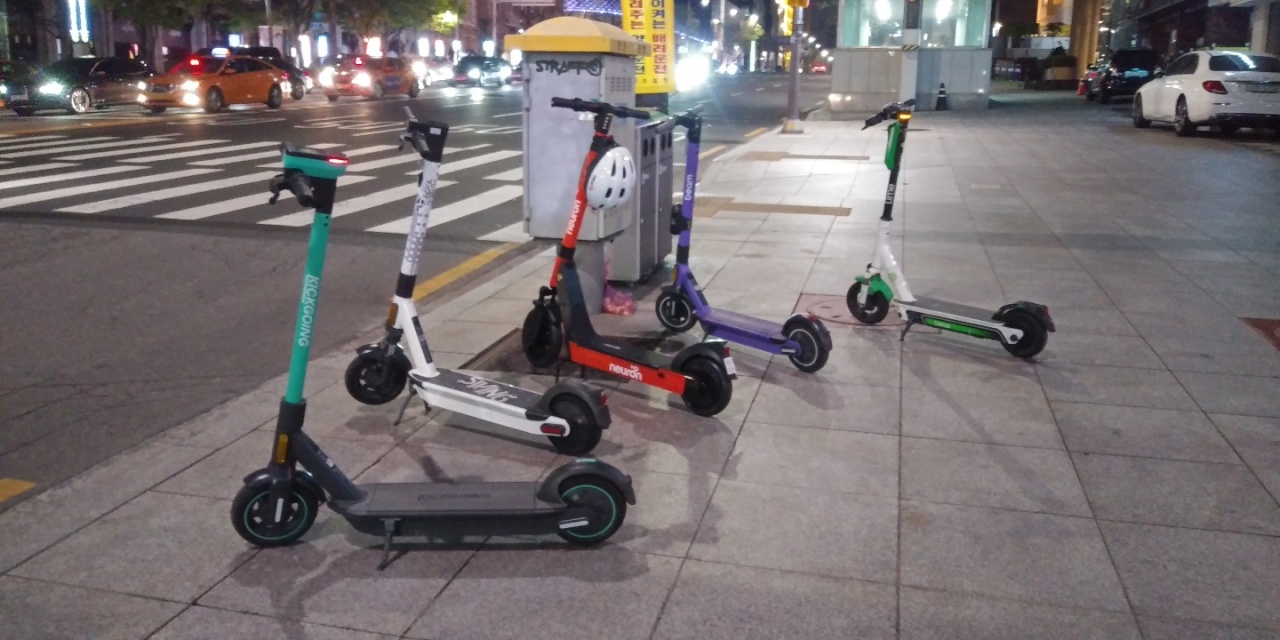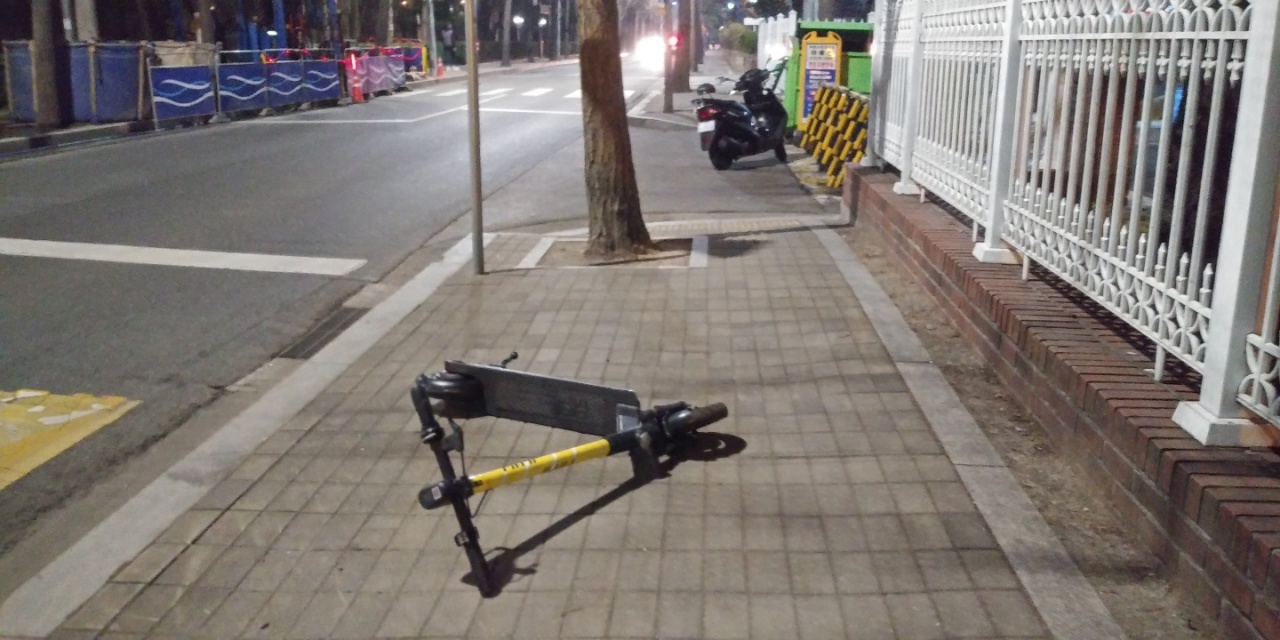
Electric scooters are parked on a sidewalk in Gangnam-gu, southern Seoul, last month. (Ko Jun-tae/The Korea Herald)
Choi Keun-ho, a 34-year-old elementary school teacher in Seocho-gu, southern Seoul, used to ride an electric scooter to and from work every day. He was one of a growing number of consumers in South Korea opting to use this rather novel personal mobility option.
But in January, after crashing into a woman and seriously bruising her, he stopped riding his scooter and instead opted to walk and take the bus. Choi said he paid the woman’s hospital bills and apologized multiple times, which the woman readily accepted.
“She couldn’t even scream, I remember that. She was just shocked in disbelief,” Choi said. “I still feel sorry for her. She even apologized to me for taking too much of my time. I was lucky enough to meet a person like that. I could have been sued, you know?”
The incident gave Choi a serious reminder of how dangerous electric scooter users can be on the road, especially for pedestrians. He stopped using electric scooter rental services altogether, and now says it is more important to care for everyone rather than just worrying about his own convenience.
“I walk more nowadays, so my legs hurt quite a bit, but I don’t have to worry about crashing into people,” he added. “The last thing I want to do is burden others, so no, I’m not going to use electric scooters for the rest of my lifetime.”
Data shows that traffic accidents involving electric scooters have increased in Korea in recent years.
According to police data obtained by Rep. Kang Gi-yun of the People Power Party, the number of reported traffic accidents involving personal mobility devices in Seoul rose 4.6 times from 29 cases in 2017 to 134 cases in 2019. Two people died and 225 others were injured, the data showed.
Considering that some minor accidents are not reported to authorities, the true numbers could be higher. Likewise, electric scooter safety has been a hot-button topic in Korea for months.
Where can users ride safely?
The problem arises from the presence of electric scooters everywhere, Seoul citizens say. Although the current law stipulates that e-scooters must stay on bike lanes, the rule is not followed, which increases the possibility of collisions.
The Road Traffic Act requires e-scooter users to use motor roads when no bike lanes are available and prohibits them from sidewalks and pedestrian paths, but not many riders are aware of this. Users know they can pay to ride, but not where they are supposed to ride.
“You trying to pick a fight with me? I don’t have time for this,” asked one electric scooter user when this reporter asked if he was aware that e-scooters were meant to be driven on bike lanes as opposed to motor roads.
“I honestly didn’t know that I have to stay on certain roads to drive this thing, and nobody has told me anything about where I should be to use this. But now that I think about it, I don’t think I have seen that many bike lanes near where I go. What do I do then?”
The lack of bike lanes has inevitably driven e-scooter users onto sidewalks, forcing them to slow down and coexist with pedestrians, e-scooter users argue. But the city has no plans at the moment to build more bike lanes to accommodate them.
According to the Seoul Metropolitan Government, the combined length of all bike lanes in Seoul as of December was 1,258.8 kilometers -- 15.2 percent the combined length of all regular roads in Seoul, which stood at 8,296.1 kilometers.
The city is building more bike lanes along Hangang-daero and the stream Cheonggyecheon as originally scheduled, but city officials said no more projects to build bike lanes are planned just yet.

An e-scooter is left abandoned on a sidewalk. (Ko Jun-tae/The Korea Herald)
Because electric scooters are owned by rental companies and can be freely picked up and parked in different locations, the question of where and how people park them after use has caused headaches.
Seoul residents such as Yoon Jin-young, 26, say they are often annoyed to see electric scooters abandoned and thrown on the street.
The city government calculates that more than 60,000 electric scooters are in use throughout the city. But because they do not require designated racks and can be left anywhere, that’s exactly what people do regardless of others’ convenience.
“I just want to freaking break them in half and shove them in trash cans,” said a convenience store owner near Apgujeong Station, who says his daily routine consists of moving at least five electric scooters away from the entrance so that people can enter his shop.
“These young people have no respect for others, and I’m sick and tired of it. I have called the district office too many times on this issue. They probably know my name and recognize my voice by now.”
The central government has designated 13 places where electric scooters should not be parked, including bus stops and entrances to buildings. But almost nobody is aware of these rules, and illegal parking has continued for months with nobody being held responsible.
Individual e-scooter rental services and district governments dispatch their own vehicles to scoop up abandoned e-scooters from the street every now and then, but it can take hours for them to arrive.
Aware of the issue, the Seoul Metropolitan Council is working with the city government to introduce a law that would see illegally parked scooters towed away for 40,000 won ($35), plus a 700 won storage fee for every 30 minutes that they remain unclaimed.
It has not yet been decided who would be held responsible for the fees, but a city government official with the transport planning bureau said the legislative revision is expected to take place within this year, as strong consensus has been reached among city council members.
Who should be allowed to ride an e-scooter?
Another problem with e-scooters in Seoul is the question of what the age requirement should be and what other credentials should be required of users. Debate had continued for months in Korea on whether people without driver’s licenses should be allowed to drive the high-speed electric scooters.
It became tricky to decide what credentials would be needed to prevent e-scooter-related traffic accidents, and who should be held responsible when such accidents occurred.
At the moment, the Road Traffic Act requires e-scooter users to be at least 13 and does not require them to have driver’s licenses. But e-scooter rental services began insisting on driver’s licenses after facing backlash over public safety.
But starting May 13, a legislative revision that passed the National Assembly in December will come into effect and many current e-scooter users will no longer be eligible.
The revision requires electric scooter users to be at least 16 and licensed to drive a motor vehicle. Users must wear protective helmets, and can have their driver’s licenses suspended if they drive e-scooters while intoxicated.
Yet the problem remains as to how law enforcement will crack down on violations, as 1.15 million people are registered to use e-scooter rental services and no monitoring system is in place.
Even e-scooter users are not aware of the new rules, and chaos is expected when they take effect. All e-scooter users that this reporter spoke with throughout Seoul said they never cared about the law on e-scooters, let alone knowing or abiding by it.
Safety should be prioritized, experts say
In the face of such problems, experts are asking Seoul to make more infrastructural investment and prioritize people’s safety. Introducing new services is important, but the move should be accompanied by the necessary legal, administrative and policy support, they say.
“It is chaotic as the existing regulatory model on bikes was simply extended to electric scooters instead of creating new regulatory standards for the new means of personal transportation,” said Choi Mi-kyung, a legislative research officer with the National Assembly Research Service, in a report.
“There is a need for regulations on electric scooters to be freshly introduced based on the unique characteristics of the mobility option in consideration of the current traffic situation.”
Choi suggested in her report that the authorities should actively advertise how electric scooters should be used, while introducing related insurance policies for electric scooter users and navigating ways to crack down on violations.
“Fundamental problems on the safety of electric scooter users, bikers and pedestrians still remain,” she added.
“Measures are needed to address expanded infrastructural needs on protecting pedestrians and allowing the coexistence of electric scooters and bikes, as well as improved road conditions for pedestrians and ways to compensate them when traffic accidents occur.”
By Ko Jun-tae (
ko.juntae@heraldcorp.com)


![[AtoZ into Korean mind] Humor in Korea: Navigating the line between what's funny and not](http://res.heraldm.com/phpwas/restmb_idxmake.php?idx=645&simg=/content/image/2024/04/22/20240422050642_0.jpg&u=)

![[Exclusive] Korean military set to ban iPhones over 'security' concerns](http://res.heraldm.com/phpwas/restmb_idxmake.php?idx=645&simg=/content/image/2024/04/23/20240423050599_0.jpg&u=20240423183955)

![[Herald Interview] Why Toss invited hackers to penetrate its system](http://res.heraldm.com/phpwas/restmb_idxmake.php?idx=645&simg=/content/image/2024/04/22/20240422050569_0.jpg&u=20240422150649)
![[Graphic News] 77% of young Koreans still financially dependent](http://res.heraldm.com/phpwas/restmb_idxmake.php?idx=645&simg=/content/image/2024/04/22/20240422050762_0.gif&u=)